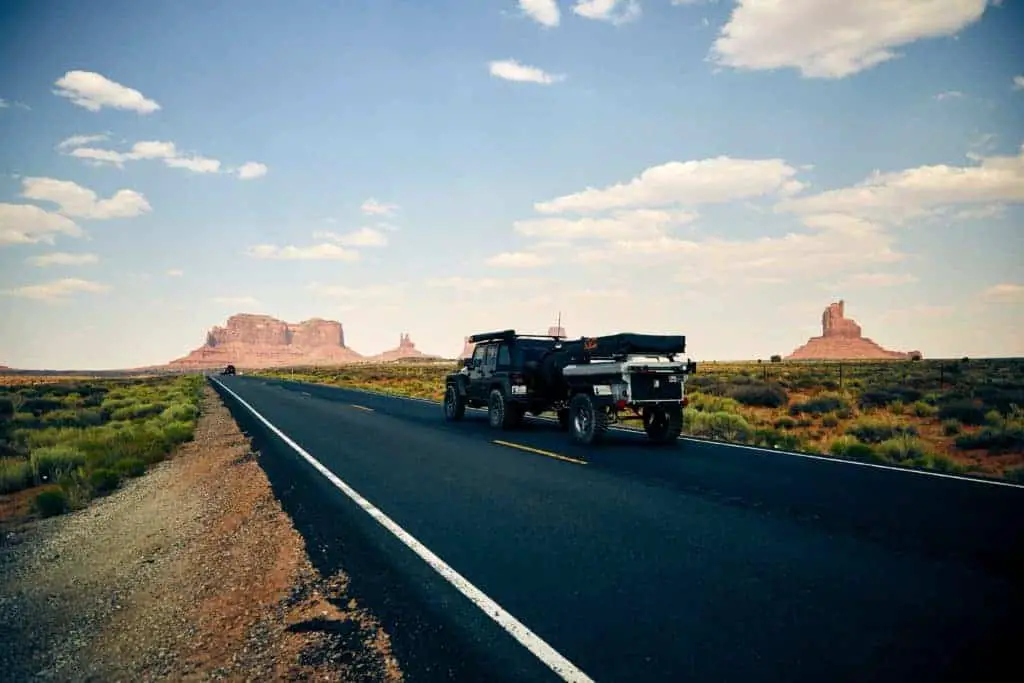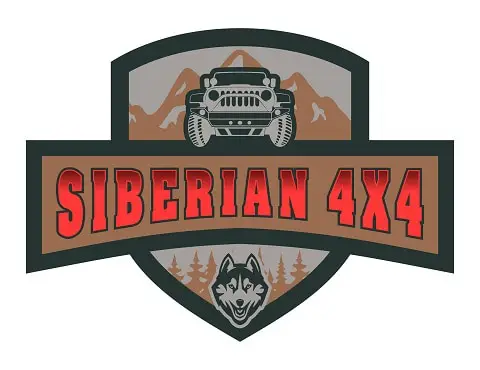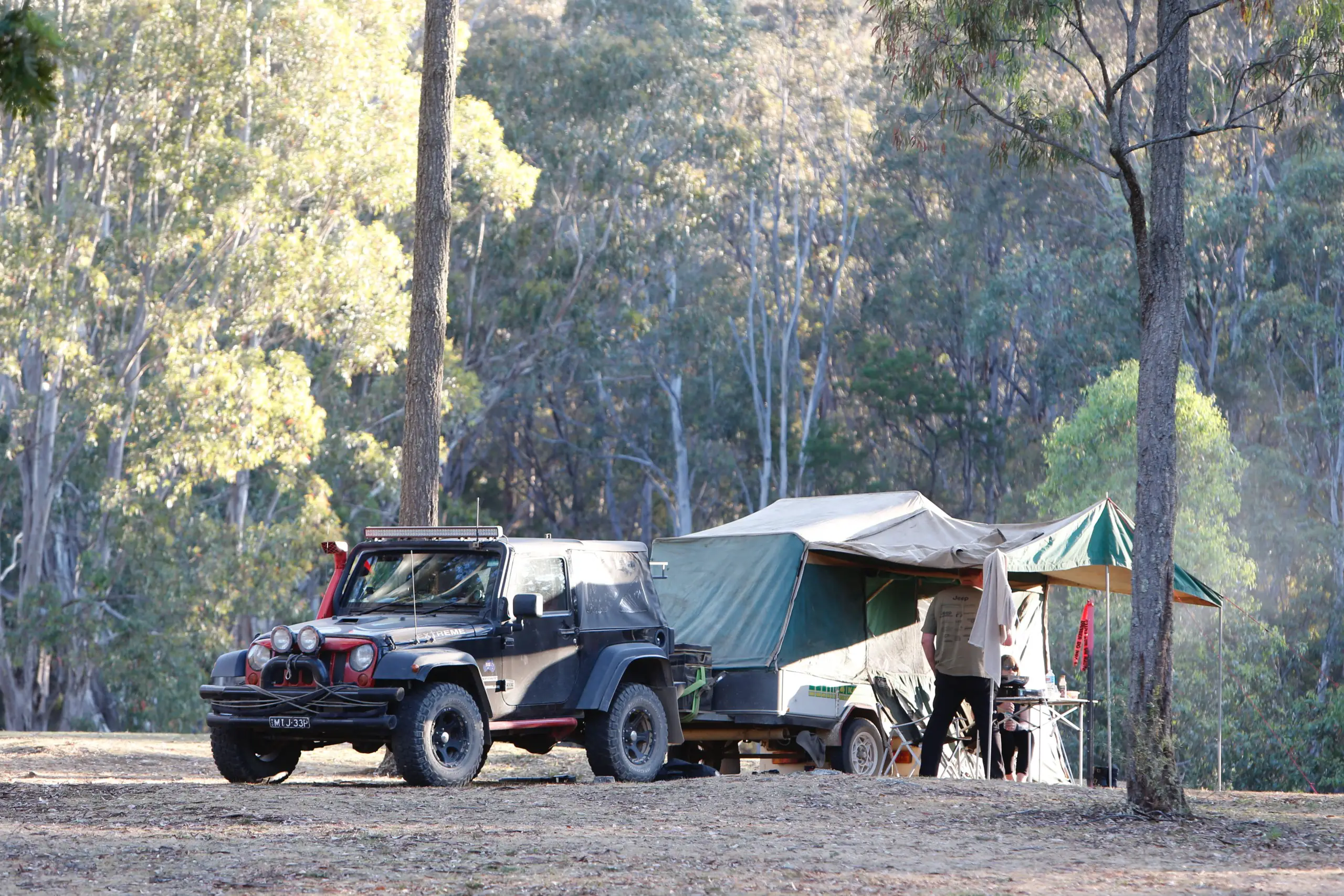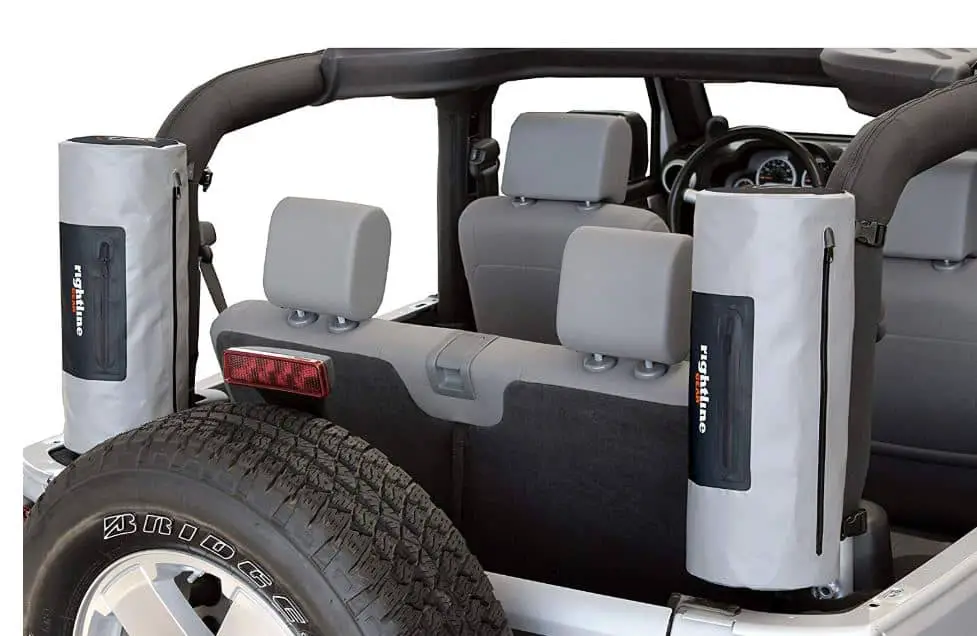So you want to go Jamping (Jeep Camping aka Overlanding) huh? Then buckle your seat belt and get ready for an adventure that never ends.
Camping by itself is an amazing time and activity. You get the chance to explore and enjoy nature and get away from the craziness of life.
However, most camping experiences are limited by available campsites and being able to get to your destination with all your equipment.
Having a Jeep changes the game of camping forever.
Pair the most capable off-road vehicle with an itch to see things most people only dream of and you get an unbeatable recipe for greatness.
What You Need for Camping in General
Before you start trying to figure out how to camp with your new favorite toy (I mean Jeep) you need to have a good idea of what camping looks like for you in general.
What kind of equipment do you usually take when you are headed for a weekend in nature? Not everyone’s journey looks the same. Knowing your needs directly corresponds to how you prepare your Jeep.
Here’s a list give you an idea of some of the basics most people (should) take camping:
- Some sort of shelter (i.e. tent, camper, trailer, etc.)
- Something to sleep on like sleepings bags and cots or an air mattress
- Chairs
- A way to cook food
- Plates, paper towels, utensils
- Trash bags
- Cooler
- First Aid
- Toiletries
The list could go on forever. One our favorite tools is this Camping Checklist from REI. It gives a great idea of things often overlooked that make for a great trip.
Once you know what you should need for YOUR camping adventures, then you begin to plan for how to make it all work with your Jeep.
Knowing Your Foundation
In the world of Overlanding, your Jeep becomes your Home for however long you are out, whether that is a weekend or a couple weeks.
Just like building a brick and mortar house, building your Jeep for camping requires having a foundation and a good knowledge of what that foundation is.
The majority of Overlanding Jeeps you will see are four door, and for good reason. When you are trying to make a home for the trails, more space is coveted.
But that doesn’t mean you can’t or shouldn’t go Overlanding in a two door Jeep.
All it means is that you need to know what you have or want and plan around that.
TrailRecon and iamjake on YouTube are two great examples of both four door and two overlanding experiences.
Beyond just having X amount of doors and space, knowing the ins and outs of your Jeep are a must.
For example, what axles do you have, what kind of suspension, what engine is in your Jeep. Knowing what you are working with allows you to know your boundaries so you don’t end up stranded somewhere.
Our advice, if you are interested in Overlanding often, is to make a list of your vehicle’s specs, a list of what you want in your overlanding experience, then a list of what you need to make sure your Jeep can handle it.
Once you know your technical specs like axles, gearing, and suspension, then you need to do some serious research as to the limitations of each. Then you can upgrade them appropriately.
If you are starting from scratch here and you don’t even have a Jeep yet, this is an amazing opportunity to know what you want ahead of buying your vehicle and saving time and money by buying a great foundation right off the bat.
Some people might be turned off to the idea of Jamping at this point because it seems overwhelming. But don’t give up! It gets better.
Siberian 4×4 stands behind doing lots of preparation in order to have a smooth and stress free experience.
There are definitely those who just throw some stuff in the back and head out and do just fine. However, we believe with proper planning in any situation will always trump not planning in the long run.
Know your foundation and move on from there.
Time to Choose a Tent…or Not.
Maybe the most noticeable aftermarket piece you will notice on an overlanding rig is the rooftop tent. Similarly, probably the biggest part of camping is some sort of tent.
To make the most use out of camping with your Jeep, you need to decide what your sleeping situation is going to look like.
The appeal to a rooftop tent for overlander is quick and simple. When you get to camp, you simply “pop open” your tent and your done.
Contrary to setting up a traditional tent where you have to find a good spot of dry flat ground, lay a tarp down, spread out your tent, fish the poles through the loops and sleeves, and finally stake it into the ground.
The down side to a roof top tent is expense, weight, and clearance. Adding a tent to your Jeeps top takes more than just throwing it on top.
You’ll have to add some sort of roof rack to your Jeep capable of holding the tent and the amount of occupants you plan on putting up there.
For people like iamjake and LiteBrite on YouTube, rooftop tents just don’t appeal.
If you watch his channel, iamjake likes to keep everything in his Jeep for security purposes. His travel is beyond just overlanding and oftentimes he finds himself sleeping in parking lots and public places.
In this case, rooftop tents are pretty vulnerable.
For LiteBrite, their reason for no rooftop tent comes down to what they use their Jeep for which is a lot of rock climbing and extreme trails. In this instance, a tent on top takes away clearance and balance.
For those who don’t want a rooftop tent, there are still options available to sleep inside your Jeep and be safe and secure. Check out Deep Sleeps blow up mattress designed to contour the four door Wranglers.
Yet another option for camping is a trailer you pull behind your Jeep. The world of off road teardrop campers has grown.
Finding a trailer that is just as capable as your Jeep is a reality in today’s world. By pulling a trailer you allow for more space inside your Jeep for whatever you need.

There are obviously pros and cons to each set up. And without taking the easy way out, it once again comes down to what YOU want with your setup.
If true overlanding and Jamping is in your future, a great rooftop tent is a smart investment.
To get some great ideas, head over TrailRecon and watch some videos of different Jeep walkarounds like the one below to see what sparks your interest.
If this is more of an every now and then kind of deal, save your money for other upgrades and find a great conventional tent or look at some setups to sleep inside your Jeep.
Maybe you plan to go on weeks of adventure at a time and have to pack out a lot more of supplies. If that’s the case, you might consider pulling a trailer for comfort, convenience, and added space for cargo.
Maximizing Your Space
Jeep Wranglers get a bad rap for lack of space and storage, especially two doors Wranglers.
However, it really is a matter of how well you maximize the space you have. Jeeps have a lot of “hidden” storage that just needs a little help getting utilized.
First things first, if you have a two door Wrangler you are looking to convert to an overlander, chances are you’ll just need to go ahead and lose the back seat.
The back seat takes up precious cargo space and serves no purpose in providing a sleeping space.
By taking out the seat, you’ve opened up 3/4 of your Jeeps tub to be turned into a masterbuilt storage facility.
How you decide to organize that space is unique to the owner. However, many have found that building a sort of elevated box specific to that back of your Jeep allows for you make drawers underneath and store stuff on top.
If you love cooking, you can even get a refrigerator like this ARB Fridge/Freezer that is designed to fit perfectly in Jeep’s limited space.
The aftermarket world for Jeep is littered with ways to maximize the space in a Wrangler. From roll bar compartments to underseat storage, you’d be surprised at just comfortably you can “live” in your Jeep.
So You Think You Can Pack?
It doesn’t matter what your current packing skills look like. Have a Jeep Wrangler is going to teach how to pack.
You’ll learn real quick all the nooks your Wrangler has that turn out to be just big enough for a tool here or an extra blanket there and so forth.
Just when you think you can’t fit any more in your rig, you’ll find the perfect cranny to carry that one last thing you needed.
In all reality, when camping in your Jeep, be smart about what you put where. Take the time to scout the inside of your Jeep and look for places to put things that will save you space for your other necessities.
One of my favorite “hiding” spots is above the sound bar. Up here I have kept an axe, shovel, and fishing rod all wrapped in an extra blanket.
Beyond that, I have found the space the between the rear roll cage bar and soft top to be a perfect platform for stacking cylinder storage containers full of whatever will fit.
How you setup your rig will determine and expose different areas for storage.
You’ll quickly learn that the first time you pack out your Jeep and organize things, won’t be the last time. The best setups usually go through multiple times of packing and repacking.
Eventually, you’ll find what works best for you and what is most comfortable for your set up. The best thing about Jeeps is that no one set up is permanent.
Mix things up and find your favorite. Even if you think your first setup is “it”, I encourage you to repack anyway. Chances are you find something you like more.
Check out these 5 different setups for inspiration!
Before moving on, head over to my post on Best Interior Accessories to see some our favorite tools for your interior that can save you some space.
Plan for Your Destination
Every trip you take and every time you go camping in your Jeep, things will be a little different.
As you get your rig set up for Overlanding or Jamping, there will be certain things that become staples for every trip.
However, I encourage you to always plan and pack for each different destination. Don’t become lazy and assume that one setup is going to work for all of your journeys.
Before each and every trip you take, make a list of things you will need unique to that journey and destination.
From there, plan and pack accordingly so that you are properly prepared. Sometimes you’ll find you don’t need a lot of things you had on the previous trip and can save yourself some weight.
If you find yourself embarking on trips regularly throughout the season, you might find a good routine to get into is a regular unpacking and cleaning of your rig at each change of season.
Everytime the weather changes, you’re needs change to be prepared.
Lastly, don’t ever take for advantage “getting by” on a previous trip. For example, say you got lucky and didn’t X piece of equipment on your last trip.
Don’t assume you won’t need that tool on your next trip. When you get home, pack it up and make sure you’re covered if you ever need it.
In short, it is usually always better to overpack then to get somewhere and really need something that you don’t have. Plan Plan Plan.
Like we’ve said before, Proper Prior Planning Prevents Poor Performance.
It Only Gets Worse from Here…
Here’s the good news…it only gets worse from here. Seriously, there’s no hope after this point. If you have any hesitation in Overlanding, STOP NOW.
Because I’m telling you, you’ll never more fun in your life than after you start building and customizing your Jeep to become your personal mobile home.
It only gets worse from here because you’ll never be done adding to or customizing your rig. You’ll catch the bug like all Jeepers and the thirst for adventure just won’t be quenched.
In all seriousness, we love Overlanding and Jamping and wish everyone could share in the experience. Camping with your Jeep is exactly what you make it.
We hope we offered you some core fundamentals in learning to camp with your rig, but in reality, just do it!
Start by throwing a tent in your back and hitting the trails. Learn from experience right??
Safety and Stay the Trail
The last two things we want to cover when camping in any fashion but especially with your Jeep are this:
- Always practice safe tactics, techniques, and behavior
- Stay the trail
Whenever you head out, be responsible. Have a high quality First Aid kit. Drive responsibly. Don’t overestimate your talents and know your limitations.
Whenever you leave the house and driveway, do your part to make it back safely.
When out on the trails, STAY THE TRAILS.
What this means is that you should never trail blaze and go off the designated path. When people do this, they ruin the environment we have been blessed to be able to use.
It gives off roaders a bad rap and gives ammunition to those who would like to see rigs removed from being able to explore like we do.
In short, be a model citizen and go above and beyond to leave a positive impact on the environment your explore. It helps everyone out.
Conclusion
You don’t have to be a pro to camp like one. Sometimes you think people like TrailRecon just started right off with an amazing rig and all the knowledge of Overlanding.
However, Brad started just like everyone else. He took the first step to get involved, surrounded himself with a great community, and built up the rig and knowledge as he went.
The best thing to do is just start now. We’ve given you the tools and ideas to start, but only you can do it. So what are you waiting for? Get up and explore. Keep the Wilderness on YOUR Side.



